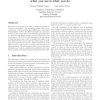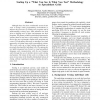685 search results - page 5 / 137 » What are you looking for |
SI3D
2005
ACM
14 years 3 months ago
2005
ACM
We present a simple yet effective snapping technique for constraining the motion of the cursor of an input device to the surface of 3D models whose geometry is arbitrarily deforme...
ICRA
2003
IEEE
14 years 3 months ago
2003
IEEE
We propose an approach for a robot to imitate the gestures of a human demonstrator. Our framework consists solely of two components: a Sensory-Motor Map (SMM) and a View-Point Tra...
VL
1999
IEEE
14 years 2 months ago
1999
IEEE
Although there has been considerable research into ways to design visual programming environments to improve the processes of creating new programs and of understanding existing o...
VL
1998
IEEE
14 years 2 months ago
1998
IEEE
We introduce visual graphs as an intermediate repren between concrete visual syntax and abstract graph syntax. In a visual graph some nodes are shown as geometric figures, and som...
ICSE
1998
IEEE-ACM
14 years 2 months ago
1998
IEEE-ACM
Form-based visual programming languages, which include commercial spreadsheets and various research systems, have had a substantial impact on end-user computing. Research shows, h...


